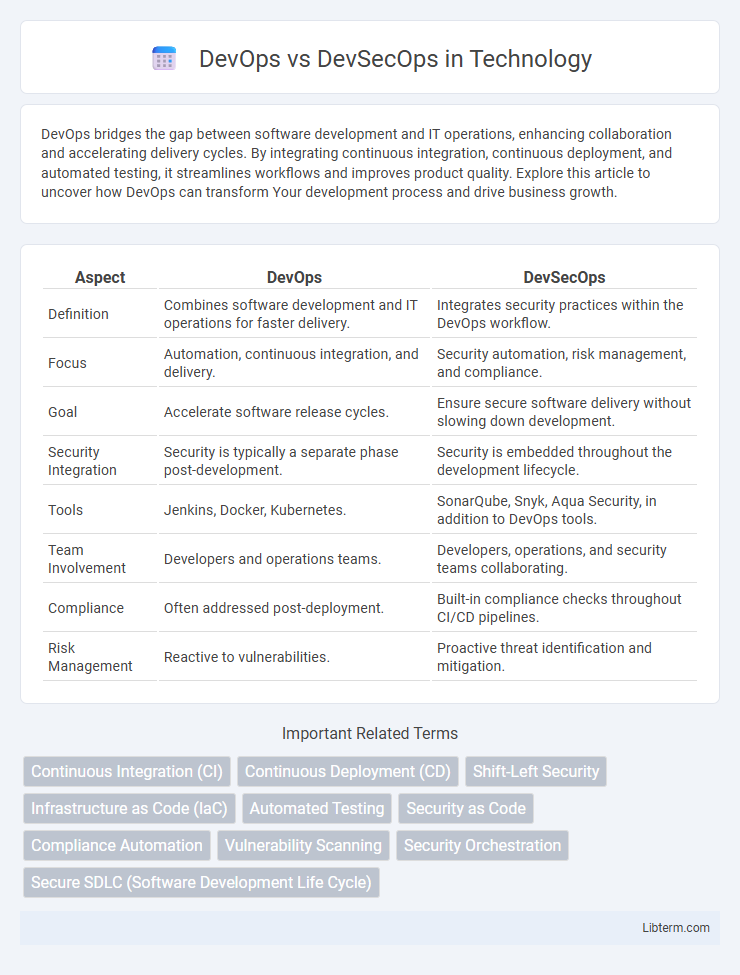DevOps bridges the gap between software development and IT operations, enhancing collaboration and accelerating delivery cycles. By integrating continuous integration, continuous deployment, and automated testing, it streamlines workflows and improves product quality. Explore this article to uncover how DevOps can transform Your development process and drive business growth.
Table of Comparison
| Aspect | DevOps | DevSecOps |
|---|---|---|
| Definition | Combines software development and IT operations for faster delivery. | Integrates security practices within the DevOps workflow. |
| Focus | Automation, continuous integration, and delivery. | Security automation, risk management, and compliance. |
| Goal | Accelerate software release cycles. | Ensure secure software delivery without slowing down development. |
| Security Integration | Security is typically a separate phase post-development. | Security is embedded throughout the development lifecycle. |
| Tools | Jenkins, Docker, Kubernetes. | SonarQube, Snyk, Aqua Security, in addition to DevOps tools. |
| Team Involvement | Developers and operations teams. | Developers, operations, and security teams collaborating. |
| Compliance | Often addressed post-deployment. | Built-in compliance checks throughout CI/CD pipelines. |
| Risk Management | Reactive to vulnerabilities. | Proactive threat identification and mitigation. |
Understanding DevOps: An Overview
DevOps integrates development and operations teams to enhance collaboration, accelerate software delivery, and improve system reliability through continuous integration and continuous deployment (CI/CD) pipelines. Key practices include infrastructure as code (IaC), automated testing, and monitoring to ensure seamless application performance. Understanding DevOps foundationally involves recognizing its emphasis on culture, automation, and feedback loops that drive agile software development cycles.
What is DevSecOps? Key Concepts Explained
DevSecOps integrates security practices directly into the DevOps workflow, ensuring continuous security across development, operations, and deployment phases. It emphasizes automation of security tests, real-time vulnerability detection, and compliance monitoring within CI/CD pipelines. Key concepts include "shift-left security," secure coding standards, automated threat modeling, and collaboration between development, security, and operations teams to reduce risks and accelerate secure software delivery.
Core Goals: DevOps vs DevSecOps
DevOps aims to accelerate software development and delivery through automation, collaboration, and continuous integration/continuous deployment (CI/CD) pipelines. DevSecOps integrates security practices into every phase of the software development lifecycle, emphasizing risk mitigation and compliance alongside speed and efficiency. Both methodologies focus on improving quality and agility, but DevSecOps prioritizes embedding security controls and vulnerability assessments from the outset.
Key Differences Between DevOps and DevSecOps
DevOps emphasizes collaboration between development and operations teams to accelerate software delivery and improve deployment frequency, while DevSecOps integrates security practices directly into the DevOps pipeline to ensure continuous security assessment and compliance. Key differences include the early incorporation of automated security testing, vulnerability management, and risk mitigation in DevSecOps, which contrasts with DevOps' focus on speed and operational efficiency. DevSecOps mandates a shift-left security approach, embedding security controls from the initial stages of development, reducing potential threats and breaches before production.
The Role of Security in DevOps and DevSecOps
Security in DevOps primarily focuses on integrating basic security practices and automated testing within the continuous integration and continuous delivery (CI/CD) pipeline. DevSecOps expands this by embedding comprehensive security measures, including vulnerability assessment, compliance monitoring, and threat modeling directly into development workflows, ensuring proactive risk mitigation. The shift from DevOps to DevSecOps reflects an evolution towards making security a shared responsibility across development, operations, and security teams throughout the software development lifecycle.
Tools and Technologies: DevOps vs DevSecOps
DevOps primarily leverages tools such as Jenkins, Docker, Kubernetes, and Ansible to automate software development, integration, and deployment processes, focusing on continuous delivery and infrastructure as code. DevSecOps integrates these tools with advanced security technologies like Snyk, Aqua Security, and HashiCorp Vault to embed security automation, vulnerability scanning, and secrets management directly into the CI/CD pipeline. The shift from DevOps to DevSecOps emphasizes proactive security measures, combining traditional development frameworks with security-specific tools to ensure robust, compliant software delivery at scale.
Benefits of Implementing DevOps
Implementing DevOps accelerates software delivery by fostering continuous integration and continuous deployment (CI/CD) pipelines, which enhance collaboration between development and operations teams. This approach reduces deployment failures and recovery times, increasing overall system reliability and operational efficiency. Additionally, DevOps promotes automation and monitoring, enabling faster feedback loops and improved scalability in dynamic cloud environments.
Advantages of Adopting DevSecOps
Adopting DevSecOps enhances security by integrating continuous security checks and automated compliance monitoring directly into the software development lifecycle, reducing vulnerabilities early. This approach improves collaboration between development, security, and operations teams, enabling faster identification and remediation of security issues. Organizations benefit from increased agility without compromising protection, resulting in reduced risks and more reliable software delivery.
Challenges in Transitioning from DevOps to DevSecOps
Transitioning from DevOps to DevSecOps presents challenges such as integrating security practices into existing CI/CD pipelines without disrupting development speed. Teams often struggle with a lack of security expertise and the need for cultural change to prioritize security alongside development and operations. Automating security testing and compliance while maintaining rapid delivery cycles requires advanced tools and continuous collaboration between developers, security professionals, and operations teams.
Choosing the Right Approach: DevOps, DevSecOps, or Both?
Choosing the right approach between DevOps and DevSecOps hinges on organizational priorities and risk tolerance; DevOps emphasizes continuous integration and delivery for faster software deployment, while DevSecOps integrates security practices into the CI/CD pipeline to address vulnerabilities early. Companies in highly regulated industries or handling sensitive data benefit more from DevSecOps due to its proactive security measures. In contrast, startups or organizations prioritizing rapid development cycles might start with DevOps and gradually incorporate security protocols, evolving towards a hybrid approach.
DevOps Infographic

 libterm.com
libterm.com